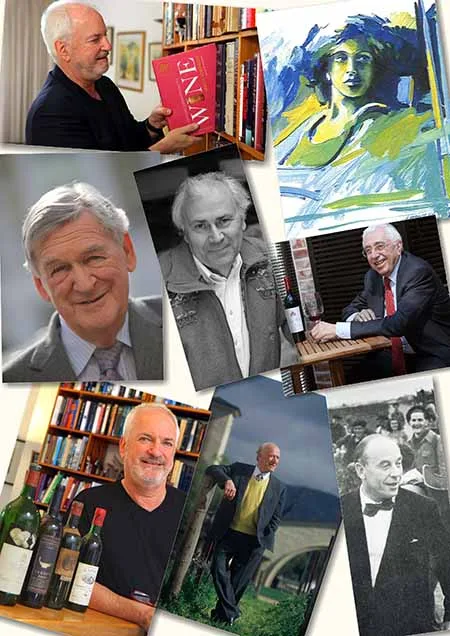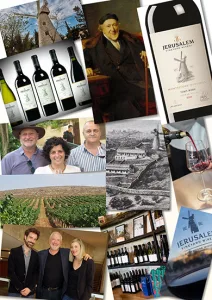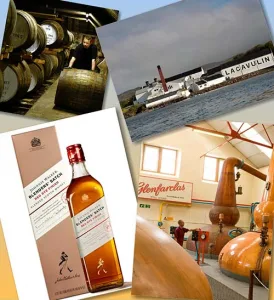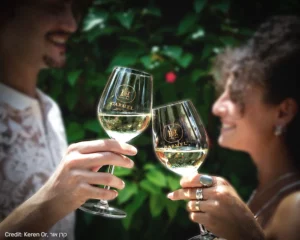I began my career in the wine, beer and spirits trade long ago in 1976, before moving exclusively to wine in the 1980’s. During nearly all this time I have worked for Bass Charrington and Bass Hotels in England, and for the Golan Heights Winery and Carmel Winery in Israel. I left Carmel in 2016 after fourteen years with them and also resigned as chairman of Montefiore Winery in 2017. Suddenly for the first time I find myself truly independent. Having just reached my 60th birthday and with the dawn of a New Year, it seems appropriate to look back at the people, the wines and the memories that have been inspirational for me. Allow me to indulge myself.
The first wine I ever remember was Palwin at family Seder Nights. This was a kiddush (sacramental) wine especially made for the British market. The word ‘Palwin’ is short for the Palestine Wine Co. which opened in 1898 in London and since then until very recently, Palwin was the largest selling kosher wine in Great Britain. The wine was sweet, warm and alcoholic. I am embarrassed to say I quite liked the taste as a child. Palwin was an integral part of the life of all British Jews. From this early wine experience, I understood there was a deep connection between Judaism and wine.
The first wine I bought through choice was called Hirondelle. This was a simple basic branded wine produced by Hedges & Butler, a 300 year old wines & spirits shippers with cellars under Regent Street in London. It was part of Bass Charrington Vintners. I seem to remember there was a red, white and rosé available in one liter bottles. The red was smooth, not astringent and inexpensive, but also with no discernable character. There is a saying ‘Brand is Bland’ and it certainly was, but it was a painless start. I found out that I liked wine.
The first great wine I had was Château Mouton Rothschild 1971. It was an epiphany moment. The color and depth of flavor were immediately noticeable as was the black fruit aroma, the full body and the whiff of cigar box. Great wine for me, like fantastic views, a memorable meal or music that is particularly moving, is an emotional experience. You don’t do justice by putting the memory into words, certainly not in a tasting note, but when it happens you don’t forget.
The Carmel Cabernet Sauvignon Special Reserve 1976 was the first Israeli table wine I came across on the wine shelves in the UK. It was Israel’s first international style wine in that it was a varietal and the first wine to be aged in small oak barrels and aged in bottle before release. The wine grew in reputation as it became older because it stayed alive for twenty years, then unheard of for an Israeli wine. Carmel had been founded by Baron Edmond de Rothschild, owner of Château Lafite, and three prime ministers of Israel, including David Ben-Gurion, worked at this historic company. This was my introduction to the history and folklore of wine in Israel
The first really great Israeli wine I had was the Yarden Cabernet Sauvignon 1985 produced by the Golan Heights Winery. The 1984 Yarden Cabernet Sauvignon had won The Winiarski Trophy at the IWSC in London, in itself an astonishing result. I remember the shock and pride in equal measure. Israel could make world class wines. However the 1985 was even better. It won three major gold medals and trophies, then exceedingly rare for an Israeli wine. I especially remember the concentration of color, aromas and flavor. It was this wine that illustrated to me that there was a future in Israeli wine. I was especially proud to put it on a number of wine lists in the UK. I admired the Golan Heights Winery’s state-of-the-art technology, leaving no stone unturned in the pursuit of quality and their pioneering efforts to advance the Israel wine. When I later moved to Israel, I was fortunate to work for them for many years.
The most memorable old wine I ever had was Château Lafite Rothschild 1947, at a private lunch at Lafite with Baron Eric de Rothschild. Talk about drinking history. It was chosen being the nearest drinkable vintage to the foundation of the State of Israel. I remember the tawny, brick color and the winey dried fruit aroma. Lafite is the pinnacle of the wine trade. It was exciting to be there. I marveled at the excellence over hundreds of years in the making of this wine, in terms of both ongoing quality and maintaining peerless standards over such a long time.
The people who had most influence on me in my formative years in wine were Jean Meyer, Serge Hochar, Baron Philippe de Rothschild, Hugh Johnson and Robert Mondavi.
Jean Meyer was an elegant, sensitive man, the fourth generation in his family domaine, Josmeyer, which was founded in 1854. When I was purchasing wine in the 1980’s, he was the supplier of wines from Alsace. What was captivating was his involvement and mastery of so many roles, not only in the vineyard, and of course, the winemaking but also marketing and sales.
He had an absolute belief in Alsace wines, and was firm in the importance of combining wine and food. He never seemed to consider wine on its own but always related it to the course it should be consumed with. However his main contribution to my own development was his belief in wine as art, comparing the winemaker to an artist.
To fulfill his dreams he made an artist label using a painting to transform the wine into an image, which was a visual expression of the wine. The works were all chosen from young Alsatian artists. For me this was a most enlightening concept that lifted wine into the realms of aesthetics and art, beyond aroma and taste. He had a boyish enthusiasm and a generosity to share. He was a wine poet and artist, who opened a window in my mind. I still have one of the early label paintings by Daniel Gasser framed at home. It is of a very beautiful slightly cold looking woman, with pastel strokes of greens, blues and yellows. The description of the painting matches the description of the wine, which in this instance was the Josmeyer Le Kottabe Riesling d’Alsace. Sadly, Jean Meyer passed away in 2016, but Josmeyer remains in good hands. One daughter manages the winery, another is the winemaker and his son in law looks after the vineyards.
Next was Serge Hochar of Lebanon’s Chateau Musar. In a world of globalization and sameness the world over, where a wine from one place tastes like another, Chateau Musar was a revelation. Whatever you thought of the wine, you could not fail to be moved and enchanted by the owner Serge Hochar. Serge was a wine philosopher for whom wine was a greater constant than religion or life itself, and more expressive to him than both. To meet him was a lesson in the art of life. He would never answer a question, but instead pose a question of his own. His own statements always ended in three dots, leaving his conversational partner time to ruminate, consider and try to catch up.
What he gave me more than anyone else was respect for the individualistic approach, for someone who follows his own way, whatever the consequences. He used to be dressed like a banker in a pin striped suit, with his French accent, expressive eyebrows, talking with his hands. He taught me about individuality, and the importance of giving a wine time to express itself. I once hosted a vertical tasting of his in the late 1980’s. It was a wonderful memory and an educational event. Vive la difference! When I later became Israeli, he would always welcome me to the Chateau Musar stand at wine exhibitions with warmth and friendship that belied the always tense relations between Lebanon and Israel.
From Château Mouton Rothschild I learnt about grandeur. I never met Baron Philipe de Rothschild, but I believe he was the leading wine figure of the 20th century. He was the first to produce Château bottled wine, the first to declassify and produce a branded wine, Mouton Cadet, now the largest selling Bordeaux wine in the world. Baron Philippe also created a unique museum of wine in art and the pioneering joint venture, Opus One, with California’s Robert Mondavi. Above all he was the only figure to get his wine upgraded in the famous 1855 Bordeaux classification.
He was the first to realize the marketing and artistic potential of the label and invited famous artists each year to paint a unique label for that years vintage. I have always had a framed poster of all the labels in my office. The poster gets bigger as the newer vintages are added to it and the older posters are then given away. When I left Carmel, there were four other people with cast off framed posters of the Rothschild labels!
In the UK, I worked for the company that represented Baron Philippe de Rothschild SA there. As such I was invited to do a harvest at the château. I was paid in francs for my work, received a signed certificate signed by the Baron and I would later receive three magnums of the vintage harvested (one of which was a 100 point wine in Robert Parker’s estimation). Nothing unstylish about Mouton Rothschild! These precious magnums were stored in a bank for twenty years and brought to Israel just in time to be enjoyed with two of my children David & Rachel, as they themselves entered a career in wine.
On that memorable visit to Mouton we toured the dark, cobwebbed cellars, with candles and saw wines from past centuries one could only dream of. In the evening we had dinner at Mouton hosted by Baroness Philippine de Rothschild. I remember the unique tall necked decanters with a red napkin tied with a flourish at the top to catch the drops. From this experience I learnt about style, quality and the grandeur of the wine world at the highest level. It was intoxicating and a life changing experience. I was hooked. By an amusing coincidence, the person who bought Château Mouton for the Rothschild family, was Nathaniel from the English Rothschilds, who happened to be a nephew of Sir Moses Montefiore, from my family. Small world.
Hugh Johnson, the world’s most respected wine writer, accompanied me as my passion for wine increased. He taught me about the joy of reading wine literature. I was enchanted by his prose and the way he painted the wine scene. His World Atlas of Wine, Wine Companion, Art & Science of Wine and Story of Wine are classics, books to read and reread. When I completed my first WSET course in London in 1979, I was given Hugh Johnson’s Pocket Wine Book. Who would have thought that I would go on to contribute to this same book on Israel and the Eastern Mediterranean for over twenty years! Anyway, since that first wine book gift, I have had an obsession with buying wine books and Johnson’s books remain amongst those I value the most.
Another person who influenced me greatly, something I share with almost everyone else the wine world, was Robert Mondavi. I met him when he came to Israel and hosted him in Tel Aviv one memorable evening. Any student of wine should follow the steps that this great man took to establish his Robert Mondavi Winery and also put the California on the map. He was a driven genius and his passion and determination were unforgettable. He showed us how to market wine, build a brand, advance wine tourism and showcase a winery. Many others who succeed follow his way. He was a tour de force.
I met him when he was already old and slightly deaf, but age could not dim the power of this inspirational character. I hosted him and his artistic wife Margrit, to dinner at Tapuch Zahav, then Israel’s finest restaurant. At the end of the meal, she made an impromptu but beautiful drawing on the paper napkin and presented it to me. It is a memento I still have. I also hosted him for a tasting of Israeli wine in London. He was always so gracious and interested.
As far as Israel is concerned, it was the much respected Peter Hallgarten of the House of Hallgarten, doyen of the English wine trade, who introduced me to the wines of the Golan Heights Winery for the first time. When I arrived in Israel I was able to better understand the potential of Israeli wines by listening to Peter Stern, the Californian wine consultant to the Golan for their first twenty years and then to Carmel for a further five years. He brought New World winemaking techniques to Israel. I was also privileged to work for Segev Yerovam the CEO of the Golan Heights Winery and later Galil Mountain, who as a manager, set the standards in Israeli wine for style and quality, the pursuit of excellence and attention to detail. To them and many more, I owe a great deal.
Robert Mondavi regularly quoted Petronius, for the memorable but simple statement: “Wine is life.” Well thanks to the wines I drank and the people that inspired me, wine became my life.
Adam Montefiore has been advancing Israeli wines for over 30 years and is often referred to as the ‘ambassador of Israeli wine’.He writes a regular column called ‘Wine Talk’ in the Jerusalem Post.
www.adammontefiore.com
PHOTOGRAPHS: Avis Mandel (Robert Mondavi), David Silverman (Adam Montefiore), Esa Korjula (Hugh Johnson).



















